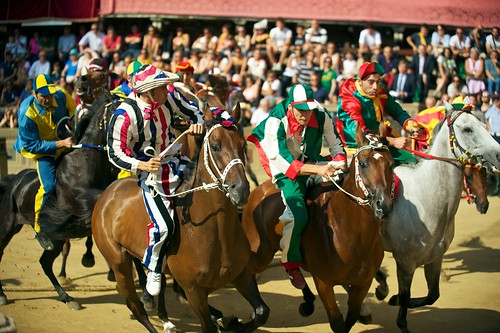
The lively and traditional Palio di Siena, aka Il Palio, horse race and pageant is held twice annually on 2 July and 16 August each year in Siena in Italy’s Tuscany region.
What is Il Palio?
The Palio di Siena, known as Il Palio to locals, is one of the oldest horse races in the world, held each year in Siena, Italy. During Il Palio, ten riders race their mounts bareback around the Piazza del Campo three times. The race usually lasts only up to ninety seconds. In the quick twists and turns of the city, it is common to see riders fall and horses finish alone. The race is held every year on July 2 and August 16. The Piazza is crammed with thousands of eager spectators, from all over the world, enjoying the fast and furious experience, as you can see in the picture below.
History of Palio di Siena
The Palio di Siena dates back to medieval times, when the Piazza was used as the center for public games, featuring the pugna, a kind of boxing match, jousting, and, of course, bullfighting. Public foot races, known as palii alla lunga, were also a feature of the games. Then, in 1590 the Grand Duke of Tuscany prohibited bullfighting, which led to the organization of the Palio races, although originally these races were held on buffalo and then donkeys, before finally settling on horses. The first modern-day Palio as we know it now occurred in 1656.
Originally, Il Palio was held only once a year, on 2 July. It is called Palio di Provenzano, after the Madonna of Provenzano, who has a church in the city. Later, a second Palio, Palio dell’Assunta, was created in honour of the Virgin Mary. It is held every year to celebrate the Assumption of Mary on August 16. These two races are one of the most eagerly anticipated festivals of the year.
The Contrade
Il Palio tradition centers on the seventeen contrade, which are city wards within Siena. For hundreds of years, the contrade contributed military and noble power to the city of Siena. Today, ten of the contrade enter horses into the Palio di Siena. Since there are seventeen contrade and only ten places in the race, the seven contrade that did not compete last year have places, with the last three entries drawn by lots from the remaining contrade. During the race, each rider dresses in the traditional colours and garb of his respective contrada.
The contrade have acted as the center of Siena culture and tradition for centuries, and as such their varied histories all contribute to the cultural richness that is Il Palio. For instance, Sienese tradition states that six contrade of the original 59 contrade were abolished after the Palio of 1675, when Contrada Strong Sword, along with the support of Contrade Rooster, Lion, Bear, Oak, and Viper, claimed the victory of Il Palio for itself instead of Contrada Wolf. As punishment, the five contrade were abolished, although they are honoured at a parade every year during the Palio.
Palio di Siena 2013
The next Palio will be held on 2 July 2013, followed by the second pageant and race on 16 August 2013. The mediaeval UNESCO listed city of Siena in Tuscany is the setting for the lively spectacle. Visitors can expect to mingle with thousands of other spectators during one of the shortest, yet most exhilarating, horse races in the world. More details can be found on the Il Palio website.











